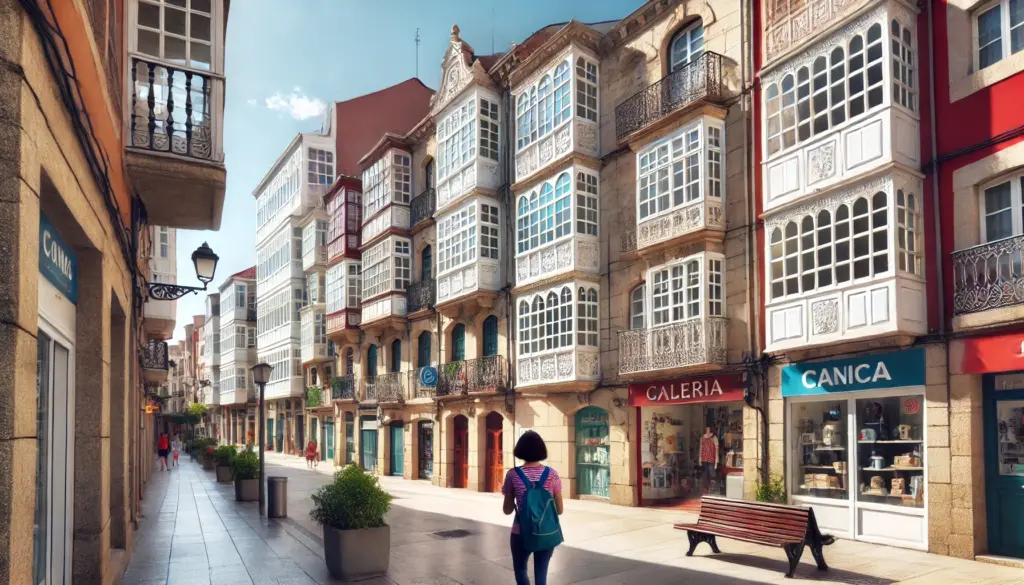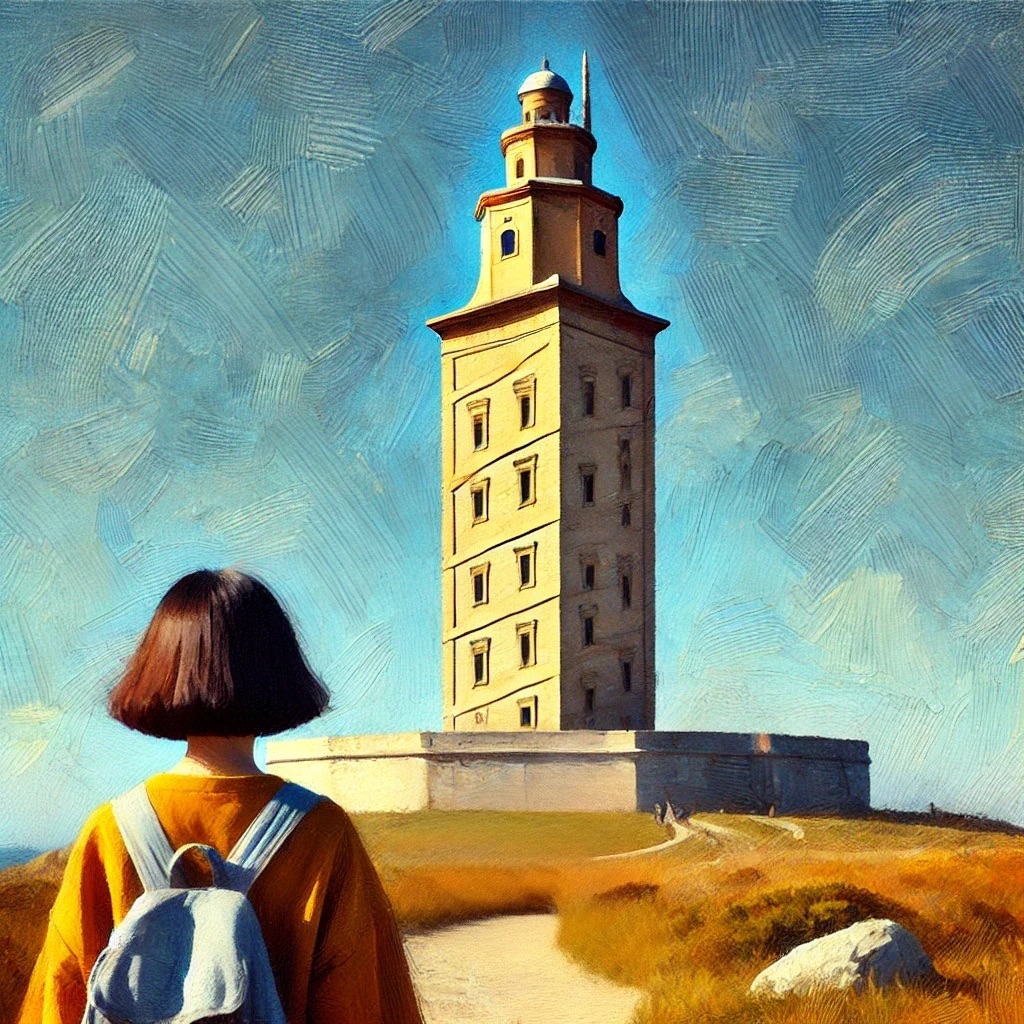ChatGPT:A Coruña, also known as La Coruña, is a vibrant coastal city in the Galicia region of northwest Spain. It’s known for its rich maritime history, beautiful beaches, and distinctive architecture. The city is home to the ancient Roman Tower of Hercules, a lighthouse that has been in continuous use since antiquity and is a UNESCO World Heritage Site.
The cityscape features a mix of modern and traditional elements, with bustling urban areas and serene seaside promenades. The Plaza de María Pita, named after a local heroine, is a central square surrounded by impressive buildings and lively cafés. A Coruña is also famous for its glazed window balconies, called “galerías,” which are a unique architectural feature of the city’s buildings.
A Coruña has a mild oceanic climate, with cool, wet winters and mild summers. The local cuisine, strongly influenced by the sea, features fresh seafood and traditional Galician dishes like “pulpo a la gallega” (Galician-style octopus). The city’s culture is also rich with festivals, music, and traditions, making it a vibrant place to visit or live.
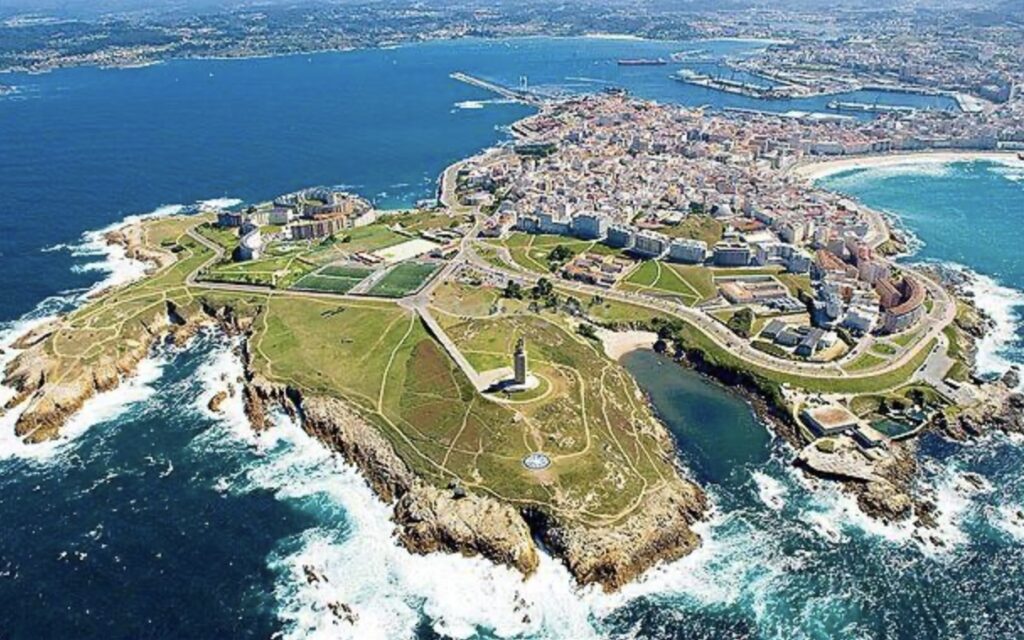
A Coruña has a rich and diverse history that dates back to ancient times. Here’s an overview of its origin, history, and development:
Origin and Early History
Pre-Roman Period:
- The area around A Coruña was inhabited by Celtic tribes before the arrival of the Romans. These early inhabitants lived in fortified settlements known as “castros.”
Roman Period:
- The Romans established a settlement called Brigantium in the area around the 2nd century BC. The most significant Roman contribution to the city is the Tower of Hercules, a lighthouse that remains one of the oldest functioning lighthouses in the world. This period marked the beginning of A Coruña as an important port and maritime center.
Medieval Period
Early Middle Ages:
- After the fall of the Roman Empire, A Coruña came under the influence of various Germanic tribes, including the Visigoths. The city’s strategic location made it a point of interest during this period.
High and Late Middle Ages:
- A Coruña grew in importance during the Middle Ages due to its port, which became a key hub for trade, particularly with northern Europe. The city’s prosperity during this time is reflected in its development, including the construction of defensive walls.
Early Modern Period
15th and 16th Centuries:
- A Coruña played a significant role in Spain’s maritime ventures during the Age of Exploration. The port was a departure point for many voyages to the New World and other parts of the globe.
- The city also saw military action, notably during the Spanish Armada’s campaign against England in 1588, and the Battle of A Coruña in 1809 during the Peninsular War against Napoleonic France.
19th Century to Present
19th Century:
- The 19th century was a period of significant growth and modernization for A Coruña. The city expanded beyond its medieval walls, with new neighborhoods and infrastructure being developed. It became an important industrial and commercial center in Galicia.
20th Century:
- A Coruña continued to grow, becoming a major urban and economic center. The city’s architecture from this period reflects both its historic past and modernization, with new public buildings, parks, and urban planning.
Modern Development:
- Today, A Coruña is a vibrant city known for its cultural heritage, beautiful coastal scenery, and modern amenities. It has developed a strong economy based on tourism, industry, and services. The city’s universities and research centers also make it an important educational hub in the region.
A Coruña’s rich history and ongoing development reflect its importance as a cultural and economic center in Galicia and Spain as a whole.
The Tower of Hercules, a Roman lighthouse located in A Coruña, Spain, is the oldest still-functioning lighthouse in the world. It was constructed in the late 1st century AD during the reign of the Roman emperor Trajan.
Functions of the Tower of Hercules
- Navigational Aid:
- The primary function of the Tower of Hercules was to serve as a lighthouse, guiding ships safely to the harbor of Brigantium (modern-day A Coruña). It was strategically positioned on a rocky promontory, providing visibility to approaching vessels from a great distance.
- Symbol of Roman Presence:
- The tower symbolized Roman engineering prowess and their dominance over the Atlantic Ocean. It was an essential part of the maritime infrastructure that facilitated trade and military movements.
- Military and Defensive Role:
- The tower’s height and position made it a valuable lookout point for spotting potential threats from the sea. It served as an early warning system against enemy ships or pirate attacks.
Construction Processes and Techniques
- Design and Structure:
- The original Roman design consisted of a square plan with a central core surrounded by an outer wall. The core contained the staircase, while the outer wall supported the structure. The tower is approximately 55 meters (180 feet) high, including its later modifications.
- The Romans built the tower using local granite, known for its durability. The structure was initially coated with stucco, possibly whitewashed to enhance visibility.
- Construction Techniques:
- Roman engineering methods involved precise stone cutting and placement. The stones were likely quarried nearby and transported to the site. The construction process would have required skilled labor, including masons, engineers, and laborers.
- The tower’s height and stability were achieved through the use of massive blocks and a thick, sturdy foundation. The interior staircase, which spirals around the central core, allowed access to the top for maintenance and operation of the light.
- Lighting Mechanism:
- Originally, the light source at the top of the tower would have been a wood fire or oil lamps. The exact method of producing and maintaining the light is not fully documented, but it would have involved a platform or brazier to hold the fire. This light served as a beacon to guide ships at night or in poor weather conditions.
- Medieval and Modern Modifications:
- Over the centuries, the Tower of Hercules underwent several modifications and restorations. In the late 18th century, it was extensively restored by architect Eustaquio Giannini, who added a new outer shell, preserving the Roman core. This restoration gave the tower its current neoclassical appearance.
- Modern additions include an automated lighting system, replacing the original fire or oil lamps with electric lights.
The Tower of Hercules was designated a UNESCO World Heritage Site in 2009, recognizing its historical and architectural significance.
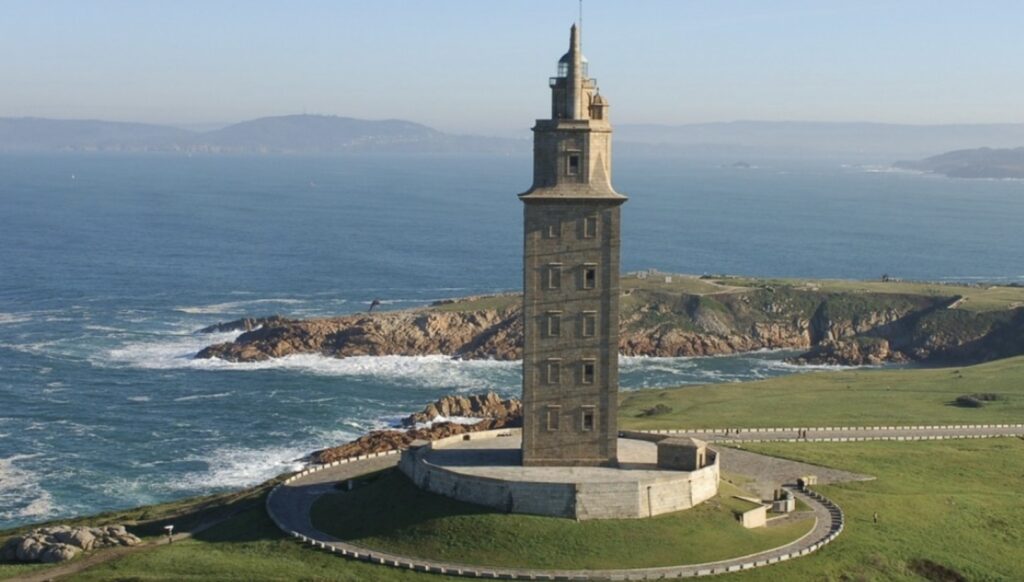
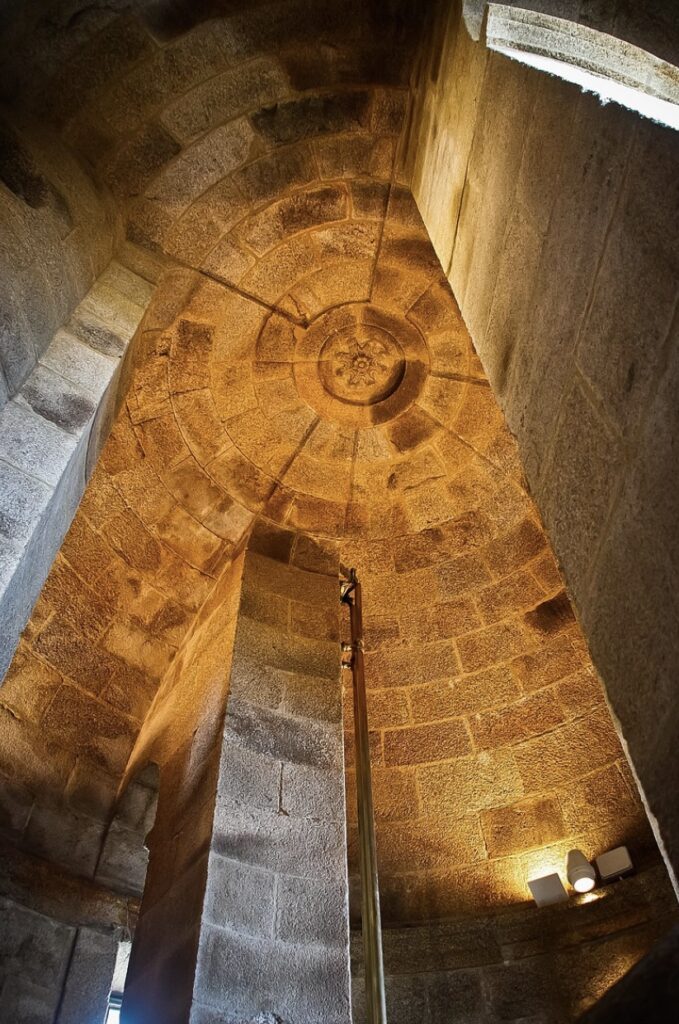
A Coruña is rich in historical monuments and tourist attractions, reflecting its diverse cultural and historical heritage. Here are some of the key sites:
Historical Monuments
Tower of Hercules:
The world’s oldest functioning lighthouse and a UNESCO World Heritage Site. It dates back to Roman times and offers panoramic views of the city and coastline.
Castillo de San Antón:
A 16th-century fortress located on a small island in the harbor, now connected to the mainland. It houses the Archaeological and Historical Museum, showcasing local artifacts and exhibits.
Iglesia de Santiago:
One of the oldest churches in A Coruña, dating back to the 12th century. It features Romanesque architecture and has been an important stop for pilgrims on the Way of St. James.
Colegiata de Santa María do Campo:
A Romanesque-Gothic church dating from the 13th century, known for its beautiful façade and historical significance.
Iglesia de San Jorge:
An 18th-century baroque church located in the city center, known for its elegant architecture and artistic interior.
Casa de las Ciencias:
A science museum housed in a former military building, offering interactive exhibits and a planetarium.
Tourist Attractions
Praza de María Pita:
The main square of A Coruña, named after the local heroine María Pita. It’s surrounded by beautiful buildings, including the City Hall, and is a central hub for events and gatherings.
Riazor Beach:
A popular urban beach located near the city center, offering beautiful views and recreational activities.
Paseo Marítimo:
A scenic promenade along the coastline, perfect for walking, cycling, and enjoying views of the ocean and the city’s landmarks.
Monte de San Pedro:
A park located on a hill with a panoramic elevator offering stunning views of the city and the sea. The park includes gardens, a maze, and a former military bunker.
Domus (Casa del Hombre):
An interactive science museum focused on the human body, designed by the architect Arata Isozaki. It offers educational exhibits and activities for all ages.
Aquarium Finisterrae:
An oceanographic museum and aquarium located near the Tower of Hercules, featuring marine life from the Atlantic Ocean and educational exhibits.
Museo de Belas Artes da Coruña:
The Museum of Fine Arts of A Coruña, housing a collection of artworks ranging from the Middle Ages to contemporary pieces, with a special focus on Galician artists.
Menhires por la Paz:
A modern sculpture park featuring stone menhirs, symbolizing peace and commemorating the victims of conflicts.
Palacio de la Ópera:
A modern concert hall and cultural venue hosting a variety of performances, including opera, concerts, and theater.
Plaza de Lugo Market: A traditional market offering a wide range of fresh seafood, local produce, and other goods, reflecting the region’s culinary richness.
These monuments and attractions make A Coruña a city rich in history, culture, and natural beauty, appealing to both locals and tourists.
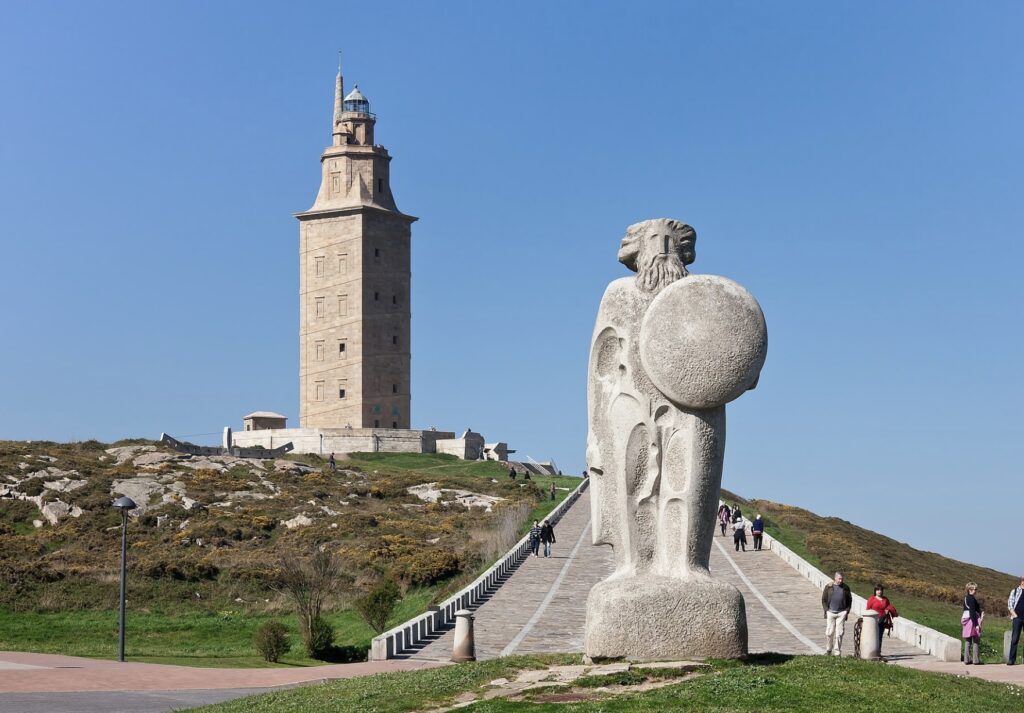
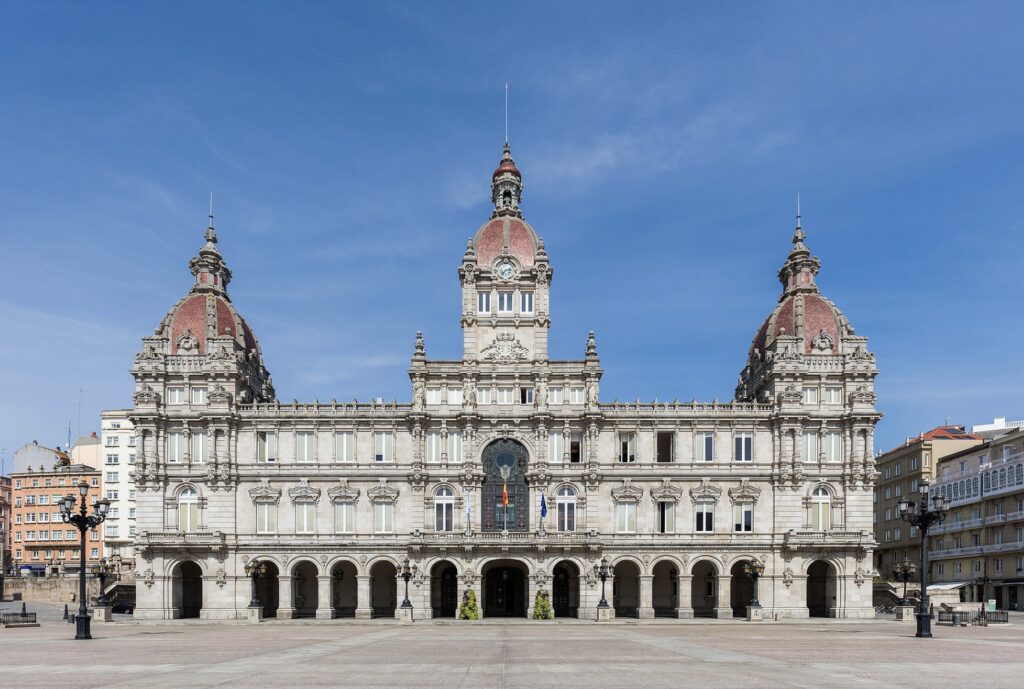
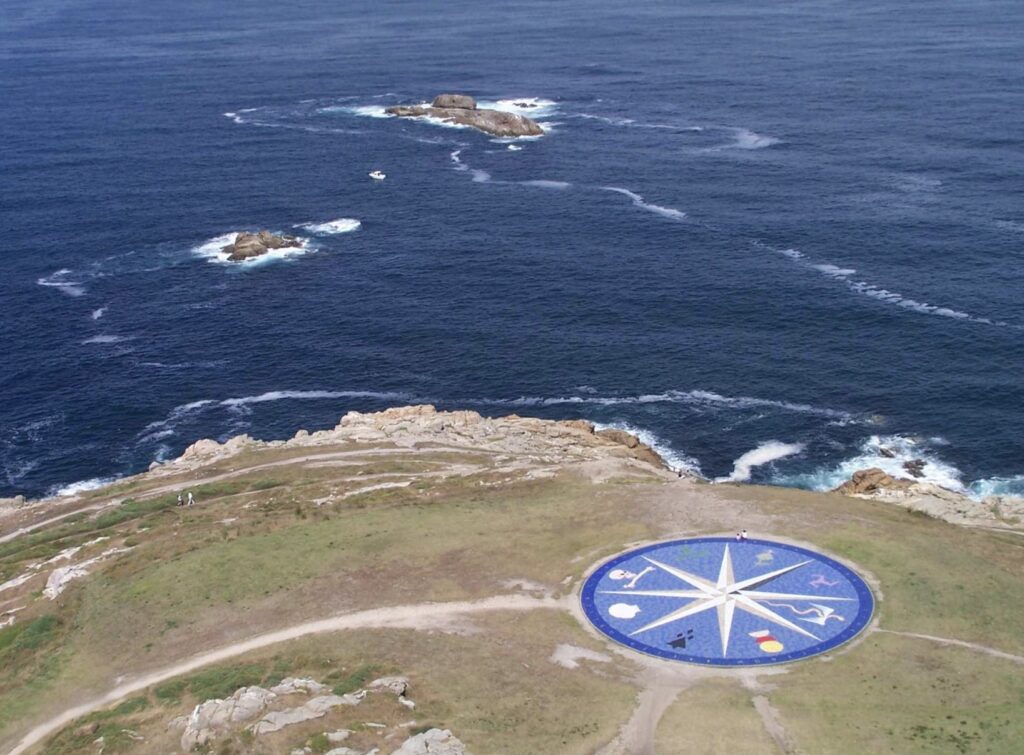
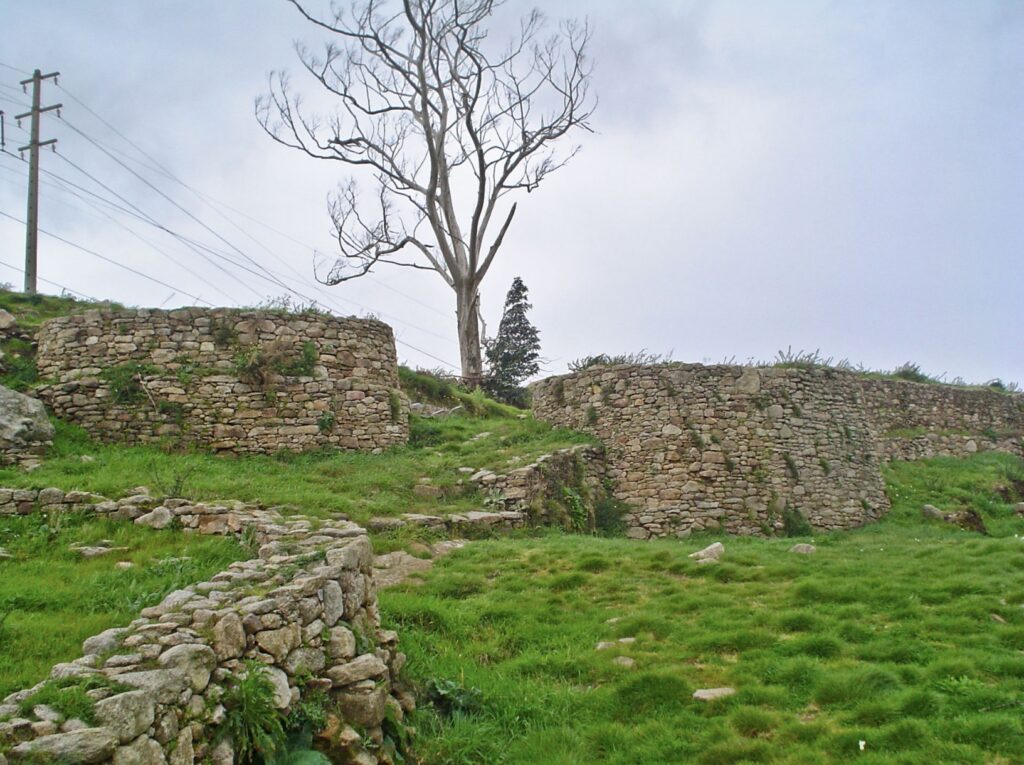
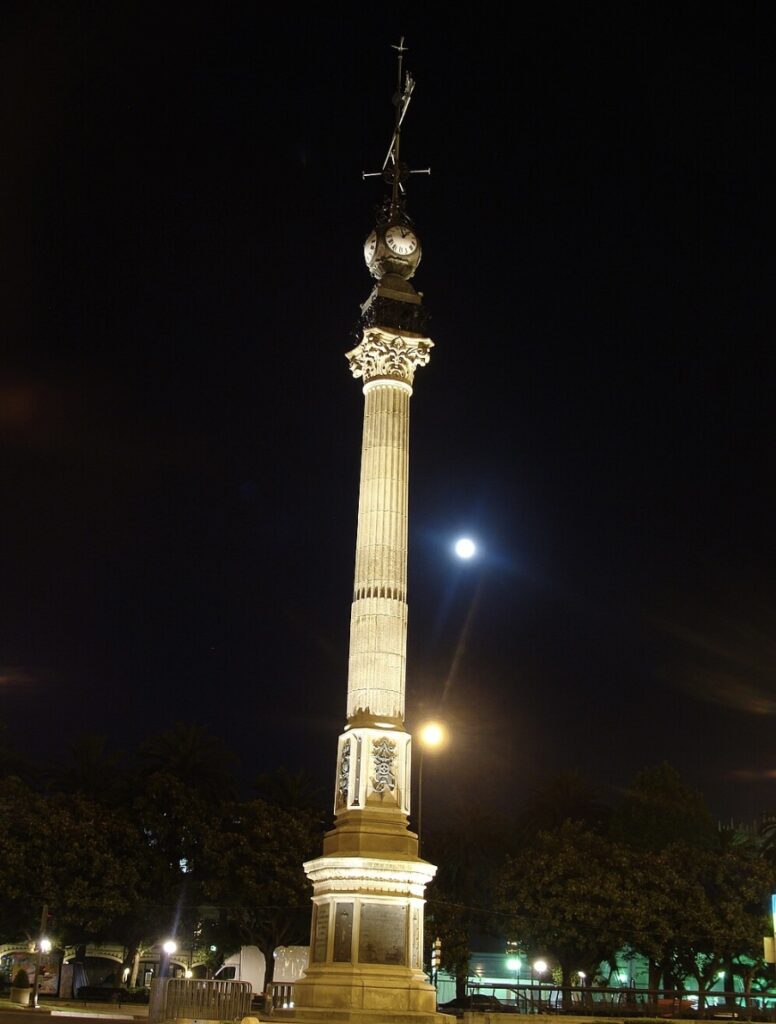
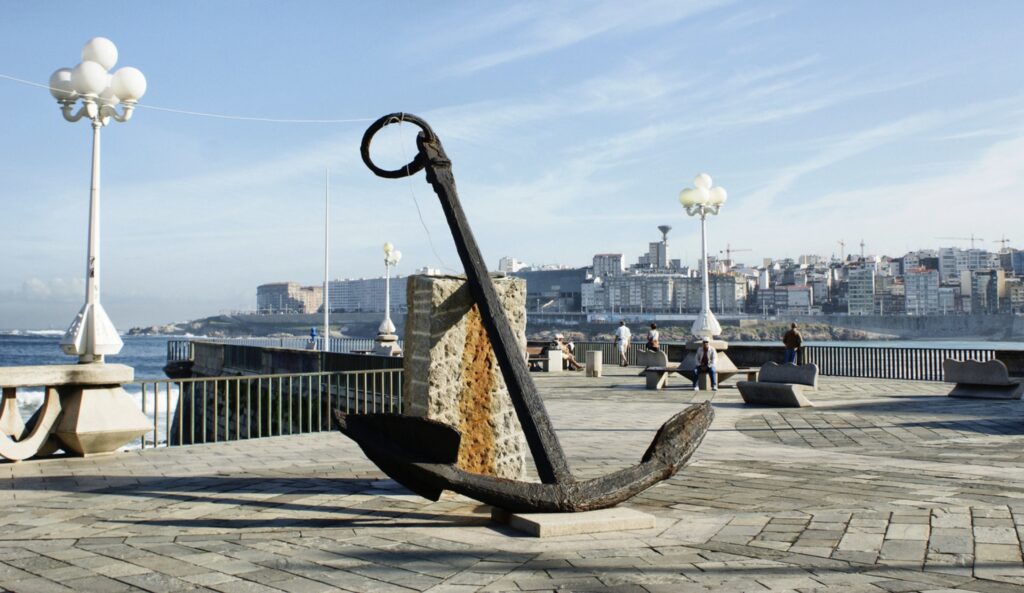
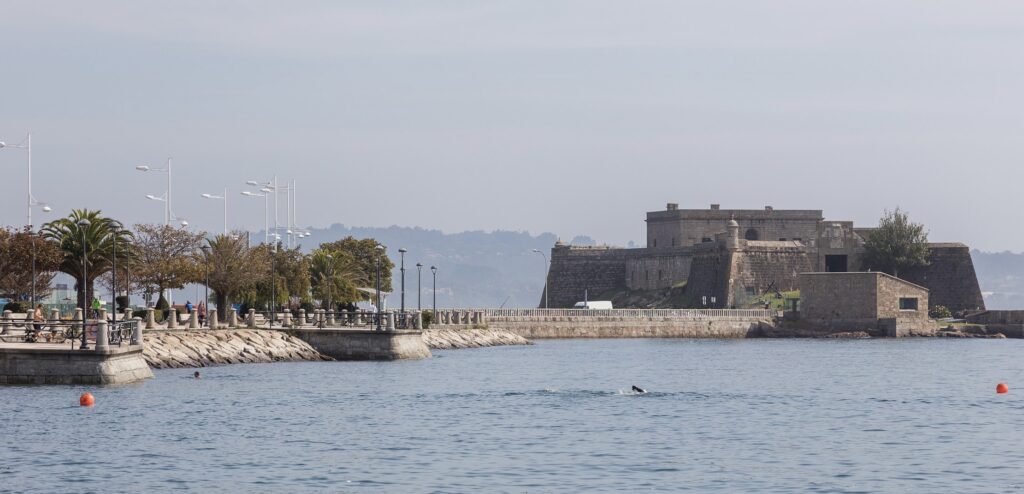
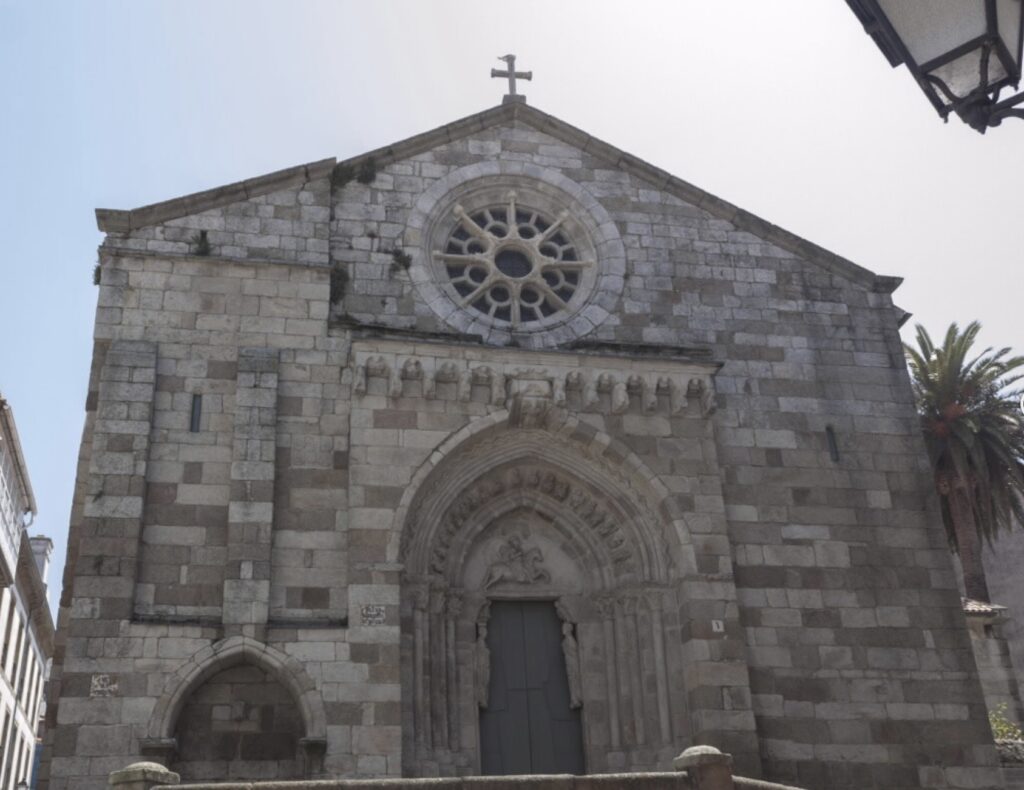
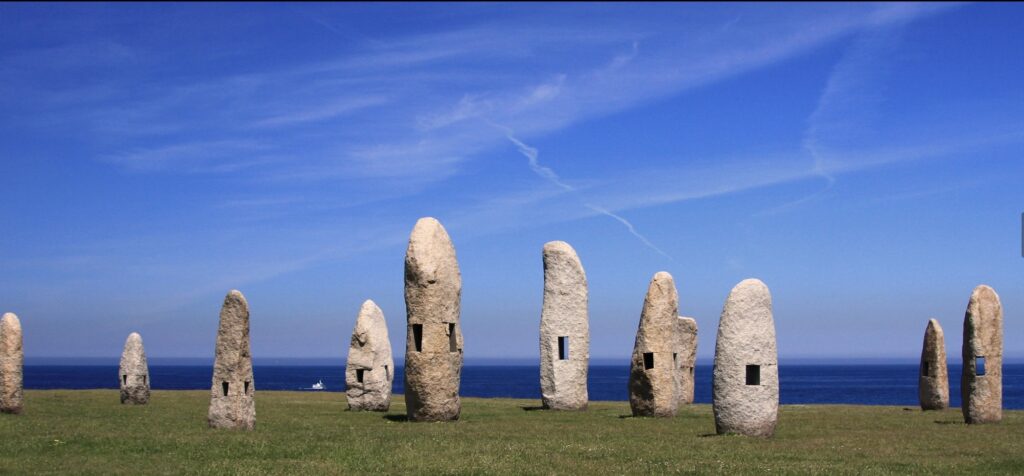
In A Coruña the balconies known as “galerías” are a unique characteristic of the city’s urban landscape.
Features and Functions of Galerías:
- Enclosed Design:
- The galerías are typically enclosed with glass, creating a kind of sunroom or conservatory that extends outward from the building’s façade. This design helps protect against the often rainy and windy weather in A Coruña while still allowing natural light to enter the space.
- Aesthetic Appeal:
- These glass-enclosed balconies are often framed with white wood or metal, giving the buildings a distinctive and elegant appearance. They are a defining visual element of A Coruña’s architectural style, particularly in the city center and along the waterfront.
- Climate Adaptation:
- The galerías are well-suited to the Atlantic climate of Galicia, where they help maintain warmth inside the buildings during cooler months and provide a sheltered space that can be used year-round.
- Historical and Cultural Significance:
- The development of these enclosed balconies is closely tied to the city’s maritime history. They were originally designed to emulate the lookout structures on ships, allowing residents to have a clear view of the port and the sea.
- Urban Planning:
- The use of galerías is also linked to urban development in the 19th century when many new buildings were constructed in the city. This period saw a blend of traditional Galician architecture with influences from other parts of Europe, leading to the popularization of this feature.
In summary, the galerías are not only a practical response to the local climate but also a cultural and architectural hallmark of A Coruña.
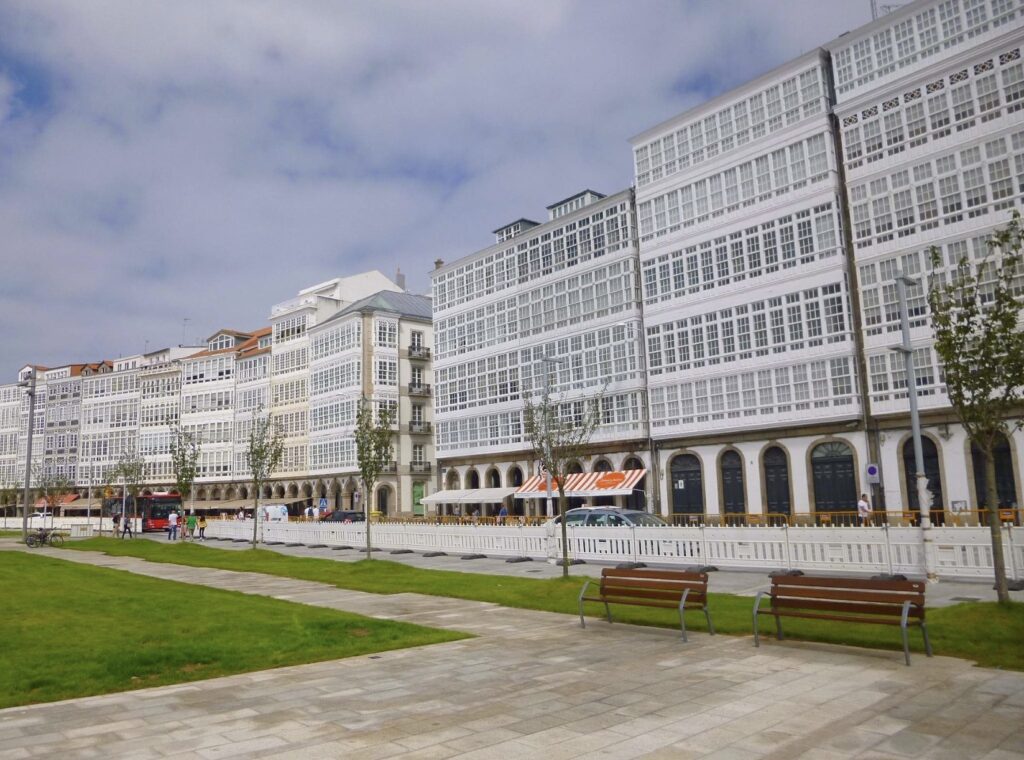
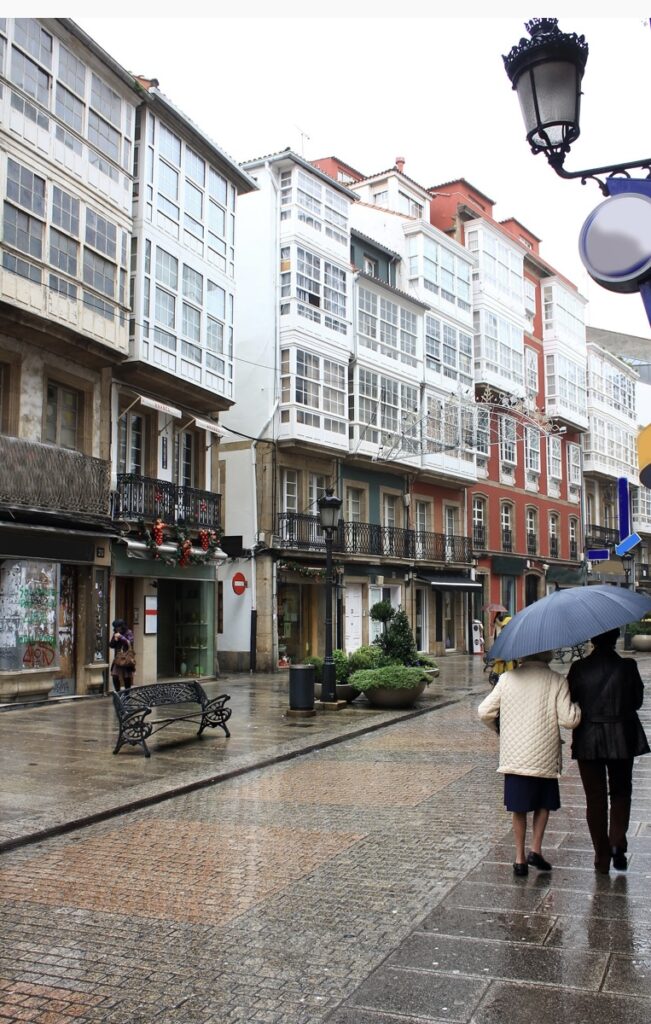
Here’s a one-day itinerary for visiting A Coruña, incorporating some of the city’s key attractions and local food specialties:
Morning:
1. Breakfast at a Local Café
- Start your day with a traditional Galician breakfast at a local café. Try “tostadas con tomate y aceite” (toast with tomato and olive oil) or “ensaimada,” a sweet pastry, along with a café con leche (coffee with milk).
2. Visit the Tower of Hercules
- Head to the iconic Tower of Hercules, the world’s oldest functioning lighthouse and a UNESCO World Heritage Site. Explore the tower, enjoy the panoramic views, and walk along the nearby coastal paths.
3. Explore Monte de San Pedro
- Take a short drive or bus ride to Monte de San Pedro, a hilltop park with spectacular views of the city and coastline. You can take the panoramic elevator for an even better view. The park also has gardens, a maze, and remnants of military fortifications.
Lunch:
4. Lunch in the Old Town
- Head to the Old Town (Ciudad Vieja) and choose a traditional Galician restaurant. Order local specialties such as “pulpo a la gallega” (Galician-style octopus), “empanada gallega” (a savory pie filled with fish or meat), and “caldo gallego” (a hearty soup with greens, potatoes, and chorizo). Pair your meal with a glass of Albariño, a popular Galician white wine.
Afternoon:
5. Stroll Through Praza de María Pita
- After lunch, take a leisurely walk through the Praza de María Pita, the main square named after the local heroine. Admire the impressive City Hall building and enjoy the atmosphere of this bustling area.
6. Visit the Museo de Belas Artes da Coruña
- Spend some time exploring the Museum of Fine Arts, which houses an impressive collection of art, including works by Galician artists and pieces ranging from the Middle Ages to contemporary art.
7. Walk Along the Paseo Marítimo
- Enjoy a scenic walk along the Paseo Marítimo, the city’s coastal promenade. This path offers beautiful views of the Atlantic Ocean and passes several beaches, including Riazor and Orzán. If the weather is nice, you can relax on the beach or take a quick dip in the sea.
Evening:
8. Dinner in the Marina Area
- End your day with dinner at a seafood restaurant in the Marina area. Enjoy fresh catches of the day, such as “mariscada” (a seafood platter), “chipirones” (baby squid), or “merluza a la gallega” (Galician-style hake). Don’t forget to try some “tarta de Santiago,” an almond cake typical of the region, for dessert.
9. Nightcap at a Local Bar
- Finish the evening with a drink at a local bar. Try “licor café,” a popular coffee-flavored liqueur in Galicia, or “queimada,” a traditional Galician alcoholic drink made from orujo, sugar, lemon peel, coffee beans, and cinnamon, often prepared with a ritual to ward off evil spirits.
This itinerary offers a taste of A Coruña’s rich history, culture, and culinary delights, providing a well-rounded experience of the city in just one day.
